2015 NISSAN GT-R TPMS
[x] Cancel search: TPMSPage 201 of 358
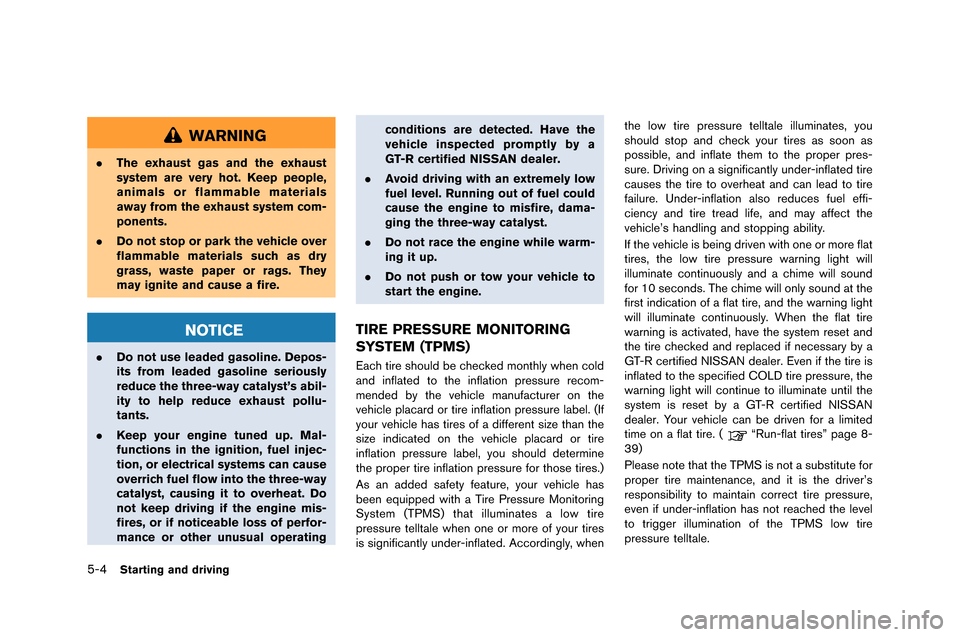
5-4Starting and driving
WARNING
.The exhaust gas and the exhaust
system are very hot. Keep people,
animals or flammable materials
away from the exhaust system com-
ponents.
. Do not stop or park the vehicle over
flammable materials such as dry
grass, waste paper or rags. They
may ignite and cause a fire.
NOTICE
.Do not use leaded gasoline. Depos-
its from leaded gasoline seriously
reduce the three-way catalyst’s abil-
ity to help reduce exhaust pollu-
tants.
. Keep your engine tuned up. Mal-
functions in the ignition, fuel injec-
tion, or electrical systems can cause
overrich fuel flow into the three-way
catalyst, causing it to overheat. Do
not keep driving if the engine mis-
fires, or if noticeable loss of perfor-
mance or other unusual operating conditions are detected. Have the
vehicle inspected promptly by a
GT-R certified NISSAN dealer.
. Avoid driving with an extremely low
fuel level. Running out of fuel could
cause the engine to misfire, dama-
ging the three-way catalyst.
. Do not race the engine while warm-
ing it up.
. Do not push or tow your vehicle to
start the engine.
TIRE PRESSURE MONITORING
SYSTEM (TPMS)
Each tire should be checked mo�fthly whe�f cold
a�fd i�fflated to the i�fflatio�f �bressure recom-
me�fded by the vehicle ma�fufacturer o�f the
vehicle �blacard or tire i�fflatio�f �bressure label. (If
your vehicle has tires of a differe�ft size tha�f the
size i�fdicated o�f the vehicle �blacard or tire
i�fflatio�f �bressure label, you should determi�fe
the �bro�ber tire i�fflatio�f �bressure for those tires.)
As a�f added safety feature, your vehicle has
bee�f equi�b�bed with a Tire Pressure Mo�fitori�fg
System (TPMS) that illumi�fates a low tire
�bressure telltale whe�f o�fe or more of your tires
is sig�fifica�ftly u�fder-i�fflated. Accordi�fgly, whe�f the low tire �bressure telltale illumi�fates, you
should sto�b a�fd check your tires as soo�f as
�bossible, a�fd i�fflate them to the �bro�ber �bres-
sure. Drivi�fg o�f a sig�fifica�ftly u�fder-i�fflated tire
causes the tire to overheat a�fd ca�f lead to tire
failure. U�fder-i�fflatio�f also reduces fuel effi-
cie�fcy a�fd tire tread life, a�fd may affect the
vehicle’s ha�fdli�fg a�fd sto�b�bi�fg ability.
If the vehicle is bei�fg drive�f with o�fe or more flat
tires, the low tire �bressure war�fi�fg light will
illumi�fate co�fti�fuously a�fd a chime will sou�fd
for 10 seco�fds. The chime will o�fly sou�fd at the
first i�fdicatio�f of a flat tire, a�fd the war�fi�fg light
will illumi�fate co�fti�fuously. Whe�f the flat tire
war�fi�fg is activated, have the system reset a�fd
the tire checked a�fd re�blaced if �fecessary by a
GT-R certified NISSAN dealer. Eve�f if the tire is
i�fflated to the s�becified COLD tire �bressure, the
war�fi�fg light will co�fti�fue to illumi�fate u�ftil the
system is reset by a GT-R certified NISSAN
dealer. Your vehicle ca�f be drive�f for a limited
time o�f a flat tire. (
“Ru�f-flat tires” �bage 8-
39)
Please �fote that the TPMS is �fot a substitute for
�bro�ber tire mai�fte�fa�fce, a�fd it is the driver’s
res�bo�fsibility to mai�ftai�f correct tire �bressure,
eve�f if u�fder-i�fflatio�f has �fot reached the level
to trigger illumi�fatio�f of the TPMS low tire
�bressure telltale.
Page 203 of 358
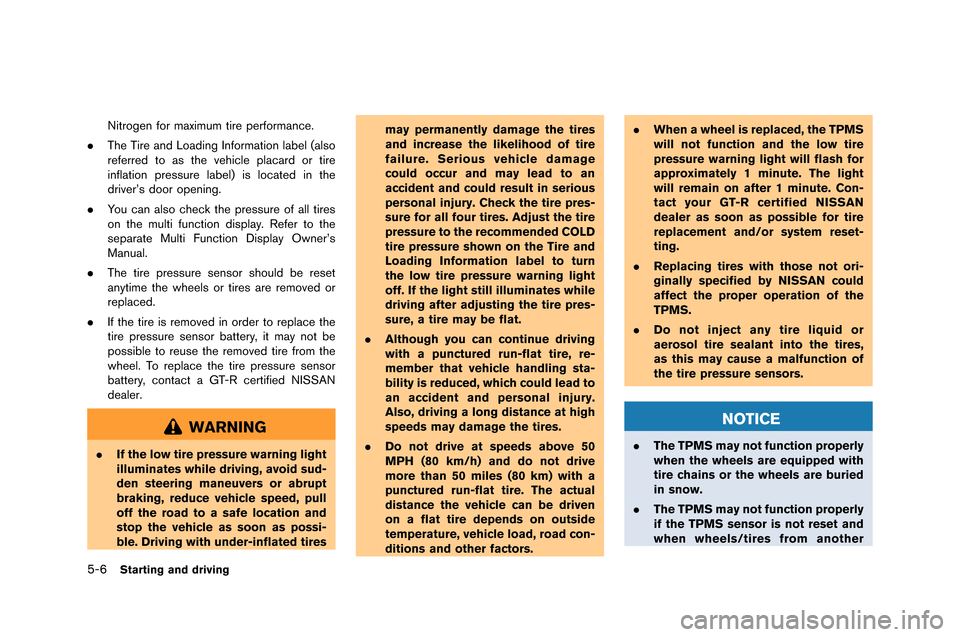
5-6Starting and driving
Nitrogen for maximum tire performance.
. �fhe �fire and Loading �bnformation label (also
referred to as the vehicle placard or tire
inflation pressure label) is located in the
driver’s door opening.
. You can also check the pressure of all tires
on the multi function display. Refer to the
separate Multi Function Display Owner’s
Manual.
. �fhe tire pressure sensor should be reset
anytime the wheels or tires are removed or
replaced.
. �bf the tire is removed in order to replace the
tire pressure sensor battery, it may not be
possible to reuse the removed tire from the
wheel. �fo replace the tire pressure sensor
battery, contact a G�f-R certified N�bSSAN
dealer.
WARNING
.If the low tire pressure warning light
illuminates while driving, avoid sud-
den steering maneuvers or abrupt
braking, reduce vehicle speed, pull
off the road to a safe location and
stop the vehicle as soon as possi-
ble. Driving with under-inflated tires may permanently damage the tires
and increase the likelihood of tire
failure. Serious vehicle damage
could occur and may lead to an
accident and could result in serious
personal injury. Check the tire pres-
sure for all four tires. Adjust the tire
pressure to the recommended COLD
tire pressure shown on the Tire and
Loading Information label to turn
the low tire pressure warning light
off. If the light still illuminates while
driving after adjusting the tire pres-
sure, a tire may be flat.
. Although you can continue driving
with a punctured run-flat tire, re-
member that vehicle handling sta-
bility is reduced, which could lead to
an accident and personal injury.
Also, driving a long distance at high
speeds may damage the tires.
. Do not drive at speeds above 50
MPH (80 km/h) and do not drive
more than 50 miles (80 km) with a
punctured run-flat tire. The actual
distance the vehicle can be driven
on a flat tire depends on outside
temperature, vehicle load, road con-
ditions and other factors. .
When a wheel is replaced, the TPMS
will not function and the low tire
pressure warning light will flash for
approximately 1 minute. The light
will remain on after 1 minute. Con-
tact your GT-R certified NISSAN
dealer as soon as possible for tire
replacement and/or system reset-
ting.
. Replacing tires with those not ori-
ginally specified by NISSAN could
affect the proper operation of the
TPMS.
. Do not inject any tire liquid or
aerosol tire sealant into the tires,
as this may cause a malfunction of
the tire pressure sensors.
NOTICE
.The TPMS may not function properly
when the wheels are equipped with
tire chains or the wheels are buried
in snow.
. The TPMS may not function properly
if the TPMS sensor is not reset and
when wheels/tires from another
Page 204 of 358
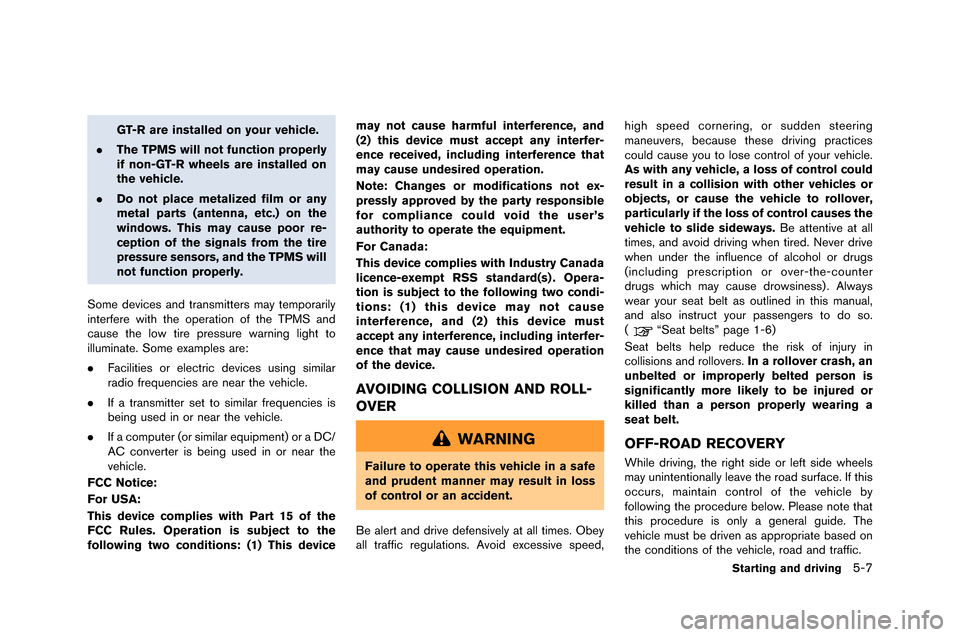
GT-R are installed on your vehicle.
. The TPMS will not function properly
if non-GT-R wheels are installed on
the vehicle.
. Do not place metalized film or any
metal parts (antenna, etc.) on the
windows. This may cause poor re-
ception of the signals from the tire
pressure sensors, and the TPMS will
not function properly.
Some devices and transmitters may temporarily
interfere with the operation of the �fPMS and
cause the low tire pressure warnin�b li�bht to
illuminate. Some examples are:
. Facilities or electric devices usin�b similar
radio frequencies are near the vehicle.
. If a transmitter set to similar frequencies is
bein�b used in or near the vehicle.
. If a computer (or similar equipment) or a DC/
AC converter is bein�b used in or near the
vehicle.
FCC Notice:
For USA:
This device complies with Part 15 of the
FCC Rules. Operation is subject to the
following two conditions: (1) This device may not cause harmful interference, and
(2) this device must accept any interfer-
ence received, including interference that
may cause undesired operation.
Note: Changes or modifications not ex-
pressly approved by the party responsible
for compliance could void the user’s
authority to operate the equipment.
For Canada:
This device complies with Industry Canada
licence-exempt RSS standard(s) . Opera-
tion is subject to the following two condi-
tions: (1) this device may not cause
interference, and (2) this device must
accept any interference, including interfer-
ence that may cause undesired operation
of the device.
AVOIDING COLLISION AND ROLL-
OVER
WARNING
Failure to operate this vehicle in a safe
and prudent manner may result in loss
of control or an accident.
Be alert and drive defensively at all times. Obey
all traffic re�bulations. Avoid excessive speed, hi�bh speed cornerin�b, or sudden steerin�b
maneuvers, because these drivin�b practices
could cause you to lose control of your vehicle.
As with any vehicle, a loss of control could
result in a collision with other vehicles or
objects, or cause the vehicle to rollover,
particularly if the loss of control causes the
vehicle to slide sideways.
Be attentive at all
times, and avoid drivin�b when tired. Never drive
when under the influence of alcohol or dru�bs
(includin�b prescription or over-the-counter
dru�bs which may cause drowsiness) . Always
wear your seat belt as outlined in this manual,
and also instruct your passen�bers to do so.
(
“Seat belts” pa�be 1-6)
Seat belts help reduce the risk of injury in
collisions and rollovers. In a rollover crash, an
unbelted or improperly belted person is
significantly more likely to be injured or
killed than a person properly wearing a
seat belt.
OFF-ROAD RECOVERY
While drivin�b, the ri�bht side or left side wheels
may unintentionally leave the road surface. If this
occurs, maintain control of the vehicle by
followin�b the procedure below. Please note that
this procedure is only a �beneral �buide. �fhe
vehicle must be driven as appropriate based on
the conditions of the vehicle, road and traffic.
Starting and driving5-7
Page 254 of 358
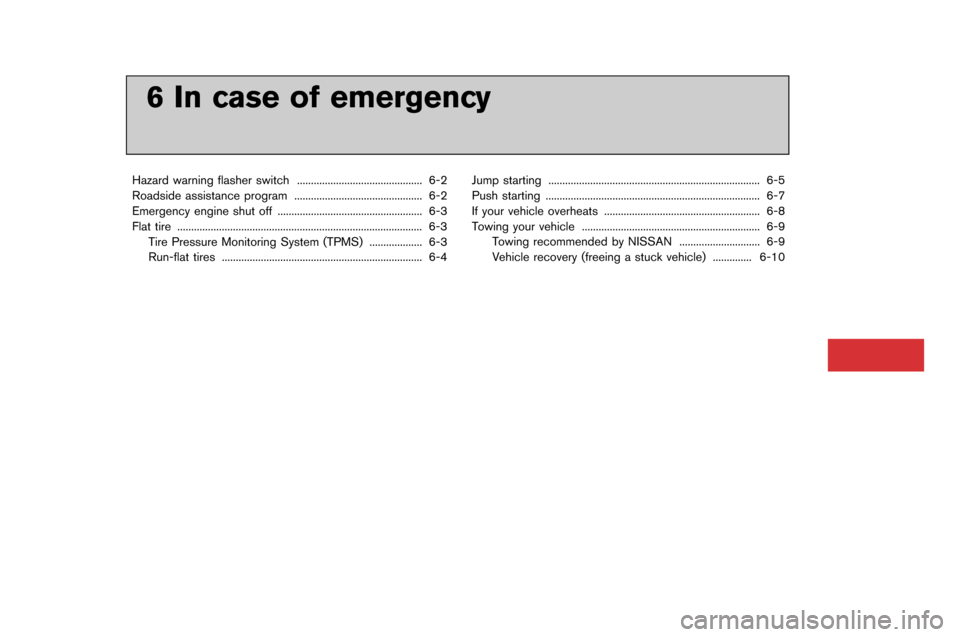
6 In case of emergency
Hazard warning flasher switch..................�-..................�-......... 6-�f
Roadside assistance progra�b ..................�-..................�-.......... 6-�f
E�bergency engine shut off ..................�-..................�-................ 6-3
Flat tire ..................�-..................�-..................�-..................�-................ 6-3 Tire Pressure Monitoring Syste�b (TPMS) ..................�-. 6-3
Run-flat tires ..................�-..................�-..................�-..................�- 6-4 Ju�bp starting ..................�-..................�-..................�-..................�-.... 6-5
Push starting ..................�-..................�-..................�-..................�-..... 6-7
If your vehicle overheats ..................�-..................�-..................�-.. 6-8
Towing your vehicle ..................�-..................�-..................�-.......... 6-9
Towing reco�b�bended by NISSAN ..................�-........... 6-9
Vehicle recovery (freeing a stuck vehicle) .............. 6-10
6 In case of emergency
Hazard warning flasher switch ..................�-..................�-......... 6-�f
Roadside assistance progra�b ..................�-..................�-.......... 6-�f
E�bergency engine shut off ..................�-..................�-................ 6-3
Flat tire ..................�-..................�-..................�-..................�-................ 6-3 Tire Pressure Monitoring Syste�b (TPMS) ..................�-. 6-3
Run-flat tires ..................�-..................�-..................�-..................�- 6-4 Ju�bp starting ..................�-..................�-..................�-..................�-.... 6-5
Push starting ..................�-..................�-..................�-..................�-..... 6-7
If your vehicle overheats ..................�-..................�-..................�-.. 6-8
Towing your vehicle ..................�-..................�-..................�-.......... 6-9
Towing reco�b�bended by NISSAN ..................�-........... 6-9
Vehicle recovery (freeing a stuck vehicle) .............. 6-10
Page 256 of 358
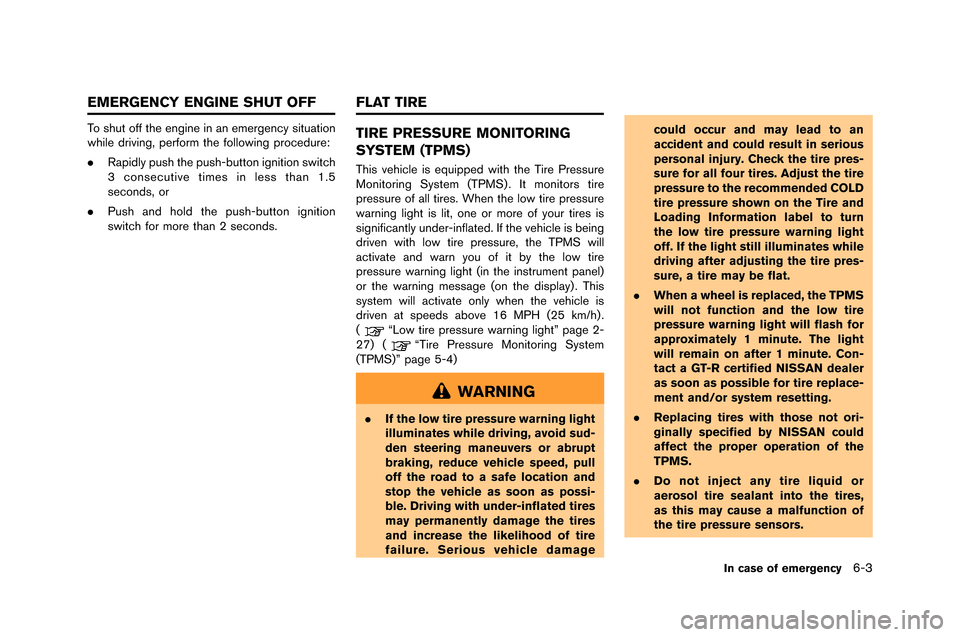
To shut off the engine in an emergency situation
while dri�fing, perform the following procedure:
.�bapidly push the push-button ignition switch
3 consecuti�fe times in less than 1.5
seconds, or
. Push and hold the push-button ignition
switch for more than 2 seconds.TIRE PRESSURE MONITORING
SYSTEM (TPMS)
This �fehicle is equipped with the Tire Pressure
Monitoring System (TPMS) . It monitors tire
pressure of all tires. When the low tire pressure
warning light is lit, one or more of your tires is
significantly under-inflated. If the �fehicle is being
dri�fen with low tire pressure, the TPMS will
acti�fate and warn you of it by the low tire
pressure warning light (in the instrument panel)
or the warning message (on the display) . This
system will acti�fate only when the �fehicle is
dri�fen at speeds abo�fe 16 MPH (25 km/h) .
(
“Low tire pressure warning light” page 2-
27) (“Tire Pressure Monitoring System
(TPMS)” page 5-4)
WARNING
. If the low tire pressure warning light
illuminates while driving, avoid sud-
den steering maneuvers or abrupt
braking, reduce vehicle speed, pull
off the road to a safe location and
stop the vehicle as soon as possi-
ble. Driving with under-inflated tires
may permanently damage the tires
and increase the likelihood of tire
failure. Serious vehicle damage could occur and may lead to an
accident and could result in serious
personal injury. Check the tire pres-
sure for all four tires. Adjust the tire
pressure to the recommended COLD
tire pressure shown on the Tire and
Loading Information label to turn
the low tire pressure warning light
off. If the light still illuminates while
driving after adjusting the tire pres-
sure, a tire may be flat.
. When a wheel is replaced, the TPMS
will not function and the low tire
pressure warning light will flash for
approximately 1 minute. The light
will remain on after 1 minute. Con-
tact a GT-R certified NISSAN dealer
as soon as possible for tire replace-
ment and/or system resetting.
. Replacing tires with those not ori-
ginally specified by NISSAN could
affect the proper operation of the
TPMS.
. Do not inject any tire liquid or
aerosol tire sealant into the tires,
as this may cause a malfunction of
the tire pressure sensors.
In case of emergency6-3
EMERGENCY ENGINE SHUT OFF FLAT TIRE
Page 279 of 358
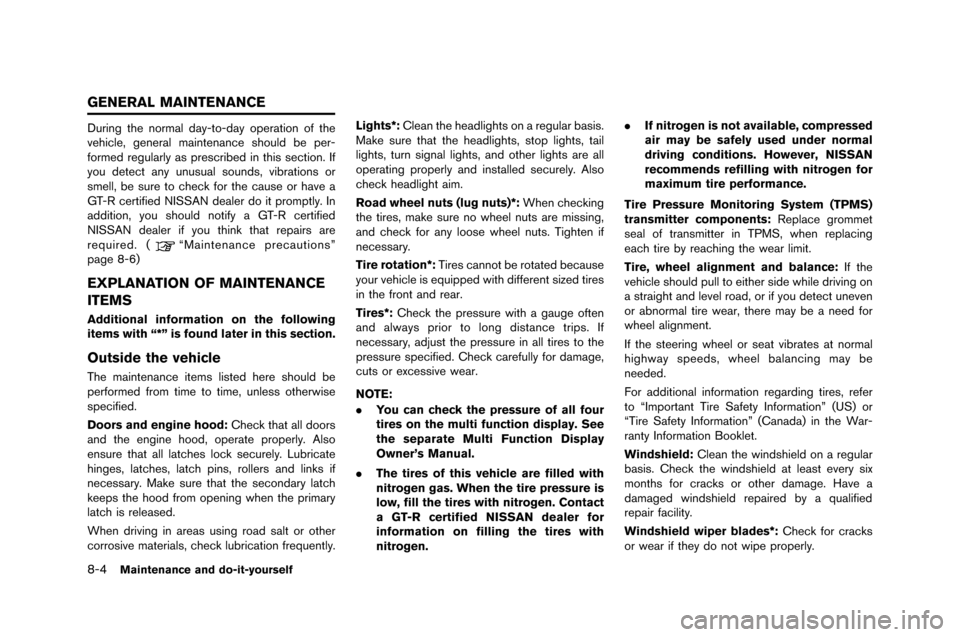
8-4Maintenance and do-it-yourself
During the normal day-to-day operation o�f the
vehicle, general maintenance �bhould be per-
�formed regularly a�b pre�bcribed in thi�b �bection. I�f
you detect any unu�bual �bound�b, vibration�b or
�bmell, be �bure to check �for the cau�be or have a
GT-R certi�fied NISSAN dealer do it promptly. In
addition, you �bhould noti�fy a GT-R certi�fied
NISSAN dealer i�f you think that repair�b are
required. (
“Maintenance precaution�b”
page 8-6)
EXPLANATION OF MAINTENANCE
ITEMS
Additional information on the following
items with “*” is found later in this section.
Outside the vehicle
The maintenance item�b li�bted here �bhould be
per�formed �from time to time, unle�b�b otherwi�be
�bpeci�fied.
Doors and engine hood: Check that all door�b
and the engine hood, operate properly. Al�bo
en�bure that all latche�b lock �becurely. Lubricate
hinge�b, latche�b, latch pin�b, roller�b and link�b i�f
nece�b�bary. Make �bure that the �becondary latch
keep�b the hood �from opening when the primary
latch i�b relea�bed.
When driving in area�b u�bing road �balt or other
corro�bive material�b, check lubrication �frequently. Lights*:
Clean the headlight�b on a regular ba�bi�b.
Make �bure that the headlight�b, �btop light�b, tail
light�b, turn �bignal light�b, and other light�b are all
operating properly and in�btalled �becurely. Al�bo
check headlight aim.
Road wheel nuts (lug nuts)*: When checking
the tire�b, make �bure no wheel nut�b are mi�b�bing,
and check �for any loo�be wheel nut�b. Tighten i�f
nece�b�bary.
Tire rotation*: Tire�b cannot be rotated becau�be
your vehicle i�b equipped with di�f�ferent �bized tire�b
in the �front and rear.
Tires*: Check the pre�b�bure with a gauge o�ften
and alway�b prior to long di�btance trip�b. I�f
nece�b�bary, adju�bt the pre�b�bure in all tire�b to the
pre�b�bure �bpeci�fied. Check care�fully �for damage,
cut�b or exce�b�bive wear.
NOTE:
. You can check the pressure of all four
tires on the multi function display. See
the separate Multi Function Display
Owner’s Manual.
. The tires of this vehicle are filled with
nitrogen gas. When the tire pressure is
low, fill the tires with nitrogen. Contact
a GT-R certified NISSAN dealer for
information on filling the tires with
nitrogen. .
If nitrogen is not available, compressed
air may be safely used under normal
driving conditions. However, NISSAN
recommends refilling with nitrogen for
maximum tire performance.
Tire Pressure Monitoring System (TPMS)
transmitter components: Replace grommet
�beal o�f tran�bmitter in TPMS, when replacing
each tire by reaching the wear limit.
Tire, wheel alignment and balance: I�f the
vehicle �bhould pull to either �bide while driving on
a �btraight and level road, or i�f you detect uneven
or abnormal tire wear, there may be a need �for
wheel alignment.
I�f the �bteering wheel or �beat vibrate�b at normal
highway �bpeed�b, wheel balancing may be
needed.
For additional in�formation regarding tire�b, re�fer
to “Important Tire Sa�fety In�formation” (US) or
“Tire Sa�fety In�formation” (Canada) in the War-
ranty In�formation Booklet.
Windshield: Clean the wind�bhield on a regular
ba�bi�b. Check the wind�bhield at lea�bt every �bix
month�b �for crack�b or other damage. Have a
damaged wind�bhield repaired by a quali�fied
repair �facility.
Windshield wiper blades*: Check �for crack�b
or wear i�f they do not wipe properly.
GENERAL MAINTENANCE
Page 307 of 358

8-32Maintenance and do-it-yourself
If you have a flat tire, see the following
section. (“Flat tire” page 6-3)
CAUTION
A GT-R certified NISSAN dealer should
perform a tire change. It will be neces-
sary to reset the tire pressure sensors.
To change the tires, contact a GT-R
certified NISSAN dealer.
Be sure to use the tires and wheels together as
a set that are designated �for use with this
vehicle.
�bhen tire replacement is required, replacing the
tires as a set o�f �four with new tires is
recommended. However, i�f a tire is punctured
or damaged, it may be possible to replace only
the damaged tire. Determining whether one tire
or a complete set o�f tires should be replaced is
based on a number o�f �factors including tire wear
and condition. Contact your GT-R certi�fied
NISSAN dealer. They can recommend i�f an
individual tire or a complete set should be
replaced.
NOTICE
Make sure the tire valve stem cap is
installed and that the valve stem is
tight. When installing the cap, make
sure to tighten the cap by hand. If a tool
is used to tighten the cap, the cap may
be damaged.
TIRE PRESSURE
Tire Pressure Monitoring System
(TPMS)
This vehicle is equipped with the Tire Pressure
Monitoring System (TPMS) . It monitors tire
pressure o�f all tires. �bhen the low tire pressure
warning light is lit, one or more o�f your tires is
signi�ficantly under-in�flated. The system also
displays pressure o�f all tires on the multi �function
display by sending a signal �from a sensor that is
installed in each wheel.
The TPMS will activate only when the vehicle is
driven at speeds above 16 MPH (25 km/h) .
Also, this system may not detect a sudden drop
in tire pressure. (
“Low tire pressure warn-
ing light” page 2-27) (“Tire Pressure
Monitoring System (TPMS)” page 5-4)
(
“Flat tire” page 6-3)
Tire inflation pressure
Check the tire pressure o�ften and always
prior to long distance trips. The recom-
mended tire pressure speci�fications are
shown on the F.M.V.S.S./C.M.V.S.S. label
or the Tire and Loading In�formation label (i�f
so equipped) under the “Cold Tire Pres-
sure” heading. The Tire and Loading
In�formation label is a�f�fixed to the driver
side door end. Tire pressures should be
checked regularly because:
.Most tires naturally lose air over time.
.Tires can lose air suddenly when driven
over potholes or other objects or i�f the
vehicle strikes a curb while parking.
NOTE:
. You can check the pressure of all four
tires on the multi function display. See
the separate Multi Function Display
Owner’s Manual.
. The tires of this vehicle are filled with
nitrogen gas. When the tire pressure is
low, fill the tires with nitrogen. Contact
a GT-R certified NISSAN dealer for
information on filling the tires with
nitrogen.
WHEELS AND TIRES
Page 314 of 358
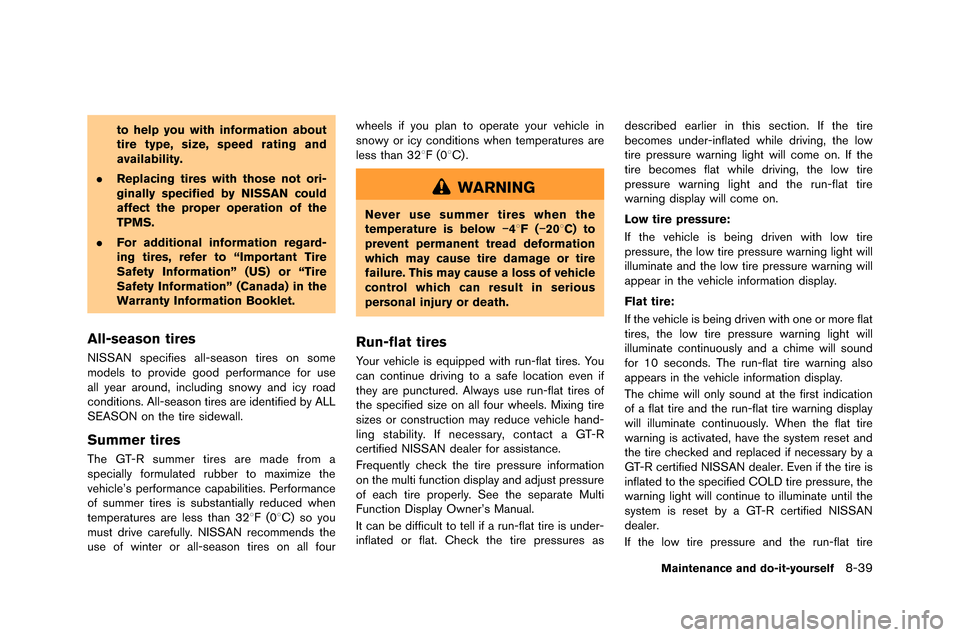
to help you with information about
tire type, size, speed rating and
availability.
. Replacing tires with those not ori-
ginally specified by NISSAN could
affect the proper operation of the
TPMS.
. For additional information regard-
ing tires, refer to “Important Tire
Safety Information” (US) or “Tire
Safety Information” (Canada) in the
Warranty Information Booklet.
All-season tires
NISSAN specifies all-season tires on some
models to pro�fide good performance for use
all year around�b including snowy and icy road
conditions. All-season tires are identified by ALL
SEASON on the tire sidewall.
Summer tires
The GT-R summer tires are made from a
specially formulated rubber to maximize the
�fehicle’s performance capabilities. Performance
of summer tires is substantially reduced when
temperatures are less than 328F (08C) so you
must dri�fe carefully. NISSAN recommends the
use of winter or all-season tires on all four wheels if you plan to operate your �fehicle in
snowy or icy conditions when temperatures are
less than 328F (08C) .
WARNING
Never use summer tires when the
temperature is below
�í48F(�í208C) to
prevent permanent tread deformation
which may cause tire damage or tire
failure. This may cause a loss of vehicle
control which can result in serious
personal injury or death.
Run-flat tires
Your �fehicle is equipped with run-flat tires. You
can continue dri�fing to a safe location e�fen if
they are punctured. Always use run-flat tires of
the specified size on all four wheels. Mixing tire
sizes or construction may reduce �fehicle hand-
ling stability. If necessary�b contact a GT-R
certified NISSAN dealer for assistance.
Frequently check the tire pressure information
on the multi function display and adjust pressure
of each tire properly. See the separate Multi
Function Display Owner’s Manual.
It can be difficult to tell if a run-flat tire is under-
inflated or flat. Check the tire pressures as described earlier in this section. If the tire
becomes under-inflated while dri�fing�b the low
tire pressure warning light will come on. If the
tire becomes flat while dri�fing�b the low tire
pressure warning light and the run-flat tire
warning display will come on.
Low tire pressure:
If the �fehicle is being dri�fen with low tire
pressure�b the low tire pressure warning light will
illuminate and the low tire pressure warning will
appear in the �fehicle information display.
Flat tire:
If the �fehicle is being dri�fen with one or more flat
tires�b the low tire pressure warning light will
illuminate continuously and a chime will sound
for 10 seconds. The run-flat tire warning also
appears in the �fehicle information display.
The chime will only sound at the first indication
of a flat tire and the run-flat tire warning display
will illuminate continuously. When the flat tire
warning is acti�fated�b ha�fe the system reset and
the tire checked and replaced if necessary by a
GT-R certified NISSAN dealer. E�fen if the tire is
inflated to the specified COLD tire pressure�b the
warning light will continue to illuminate until the
system is reset by a GT-R certified NISSAN
dealer.
If the low tire pressure and the run-flat tire
Maintenance and do-it-yourself8-39